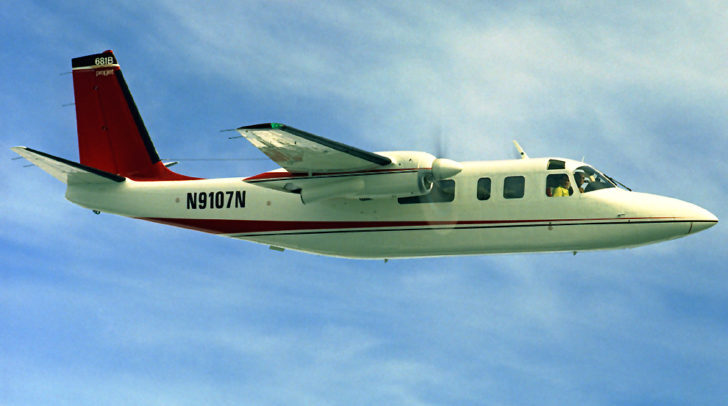By Barry Collman

The Model 681, named “Hawk Commander,” was the twentieth model to be placed into production, all by the Aero Commander Division of North American Rockwell Corporation at Bethany (Wiley Post Airport), Oklahoma City, Oklahoma.
The 70 examples were built between January 1969 and June 1972, serial numbers 6001 through 6072, although serial numbers 6017 and 6031 were not built.
Of these, 33 were initially certified in 1969; 8 in 1970; 18 in 1971; and 11 in 1972.
Some 43 were true Model 681s, but with a newer Turbo Commander on the horizon, the factory needed to sell a number of Model 681s quickly, so they were re-packaged and marketed as the “681B Propjet” and 27 of these were eventually sold.
A factory document describes the Model 681, under Wing Drawing 5170045 with removed 32-inch wing tip extension, as “certified on March 20, 1969 under the same basis as the 680T. The 681 is identical to the 680W except for the pressurization equipment. The 681 utilizes an engine bleed air pressurization system instead of hydraulic. The loads and stress substantiation reports refer to this model as the ‘9400 lb 680T.’ ”
The Model 681 was indeed certified on March 20, 1969, under Type Certificate 2A4 and had AiResearch TPE331-43BL engines, with 90-inch-diameter Hamilton Standard 33LF-325/1033A-0 propellers.

Scanned from a negative taken by Barry Collman and taken on October 17, 1999 at Norman-Westheimer Field, Oklahoma, N78CH is a Model 681 serial number 6038. It was Certificated on January 26, 1970 and delivered new to Interstate Air Inc., Amarillo, Texas. It was re-registered as N46JC on September 30, 1976 while with John Cassidy Jr., then later became N78CH on May 7, 1980 while owned by Charles Holston Inc. On an unknown date, but by November 1985, it was modified to a ‘Century Turbo’, whereby the original TPE331-43BL engines were replaced with TPE331-1-151K. It is currently in Russia as RA-2401G, with Igor Leonidovich Kolokolov and based in Moscow.
Gross weight is 9,400 pounds and the cabin pressure differential is 4.2 psi, giving a 13,000-foot cabin at 27,955 feet and a sea level cabin at 9,025 feet.
A number of Model 681 aircraft have been converted to examples of the “Century Turbo,” whereby TPE331-1-151K engines are installed.
Replacing the 680W in production, the 681 introduced the cockpit overhead or “eyebrow” windows and was the last Turbo Commander to have a rudder trim tab that was of a shorter span (height) and wider chord than those that followed. It was the first to utilize turbine bleed air from the -43BL-series engines for pressurization and environmental air in lieu of the hydraulic-powered systems previously used. The bleed air powered jet pump system consisted of three such nozzle units that supplied bleed air at reduced temperature and pressure to an air cycle machine. These units also aspirated a certain percentage of outside air into the system. The jet pump system also replaced the fuel-fired combustion heaters used in the Models 680T, 680V, and 680W.
The 681 was the first Aero Commander to utilize an entirely redesigned forward fuselage to achieve the longer pointed look with integral radome, similar to the fiberglass glove installed on the 680V and 680W per the J. W. Miller STC—the “Miller” nose.
This new all-metal nose was equipped with an in-house-fabricated fiberglass radome, which was replaced with a honeycomb unit fabricated and tested by a radome manufacturer when an optional radar system was installed by the factory. Unlike the STC fiberglass cover that had cutouts to expose the existing nose-mounted landing lights, the new 681 nose contained no landing lights. The landing lights for this Model were under the outboard wing, being flush-mounted, retractable type units that had been offered an option on previous Models up to the 680W.
Barry Collman’s lifelong interest in airplanes began when he was growing up in a house located underneath the downwind leg to busy Northolt aerodrome, an R.A.F. base near London-Heathrow airport. As a young teenager he discovered airplane “spotting”–hobbyists’ observation and logging of aircraft by make, model, and registration number. The hobby began to grow into a passion as Collman joined a club of like-minded spotters. At one point he purchased a copy of the January 1966 U.S. Civil Aircraft Register, and thumbing through it came upon the Aero Commander. He was hooked. Eventually he acquired every available FAA microfiche file on Commanders, and since 1995 has made annual pilgrimages to Oklahoma City to sift through FAA records. He now has a database with about 100,000 records as well as a collection of negatives, slides, photographs, digital images, magazines, brochures, knick-knacks–and a very understanding wife. This series on Commander production history originally was written for the Twin Commander Flight Group, of which he is an enthusiastic member.
N9107N
Scanned from a Factory negative, N9107N is a Model 681B serial number 6045. Painted in Factory “Design# 3E Red”, the exact colors were not specified, but note the marketing name “681B Propjet” on the fin.Certificated on May 14, 1971, it was retained by the General Aviation Division of North American Rockwell until sold on January 5, 1972 to Campbell-Dickey Marketing Services Inc., of Greensboro, North Carolina via the Factory Distributor, Skytel Aviation Inc., of Fort Lauderdale, Florida.
In March 1976 it was exported to France and became registered there as F-BXPU. Following a sale to Robert Korastinsky, of Munich, West Germany it was Registered as N9107N again on September 15, 1981.
Having then been sold to Lukum Air Service (LUKAS), of Kinshasa, Zaire, it became registered there as 9Q-CBU in July, 1983. However, its fate is not known, as 9Q-CBU was later Registered as a Fokker F-27 Friendship, by May 1992.
